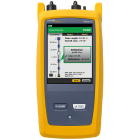It’s That Time of Year Again – Beware of Ghosts and Dead Zones!
October 24, 2018 / General, 101 learning, Installation and testing, Upgrading and troubleshooting, Best Practices
There’s a chill in the air, leaves are falling and it’s time for all things spooky. So we thought that in the spirit of Halloween, we would post this blog again that takes a look at two of the most confusing (and perhaps scariest) OTDR events--ghosts and dead zones.
When You See What Doesn't Exist
By now you should know that an OTDR calculates signal loss based on the amount of reflected light, or backscatter, that it detects. Connection points along the fiber demonstrate a large reflection, which is used to determine the return loss of the connection. When there is a poor connection, light can bounce multiple times between events. Not only will light be reflected back towards the OTDR, it will also reflect in the opposite direction towards the far end, which is then reflected back again.
The result of these "echos" of light bouncing back and forth between events are non-existent events that show up on an OTDR trace. These ghosts are pretty spooky--you can see them on the trace, but they aren't really there.
If you're not a highly experienced OTDR user, it can be difficult to identify a ghost from a real event by looking at just the trace itself. Events that exhibit no loss or show repetition an equal distance down a trace are probably ghosts. Thankfully there's no reason to be scared since Fluke Networks' OptiFiber® Pro identifies cable and fiber ghost events and ghost sources.
But it you really want to be a "Ghostbuster" this Halloween, make sure that all your fiber connections are properly cleaned, properly mated and are of a good quality before testing.

Don't Stay There Too Long
Just like it takes your eyes a minute to recover from a bright light, OTDRs can also become temporary blinded by a high reflective event. The amount of time it takes the ODTR to recover is the source of what’s called the “dead zone”--either an event dead zone or an attenuation dead zone.
An event dead zone is the minimum distance after an event where the OTDR can detect another event. If the length of fiber between two events is not long enough for the OTDR to recover, it can't properly measure the loss of the second event. The attenuation dead zone is the minimum distance required to make a loss measurement for an event.
Short dead zones enable OTDRs to accurately detect consecutive and closely spaced events in a link. Other than avoiding the risk of being eaten by zombies, shorter dead zones are preferred to make sure all connections are
identified and calculated, which is especially important when you consider the number or shorter fiber jumpers used to make connections in today's virtualized data centers.
So when evaluating an OTDR, it's important to know what reflectance is used for dead zone specifications. The lower the reflectance, the smaller the dead zone. So stick with the OptiFiber® Pro and its ultra-low reflectance specifications and ultra-short dead zones.
And Happy Halloween from all of us at Fluke Networks.






